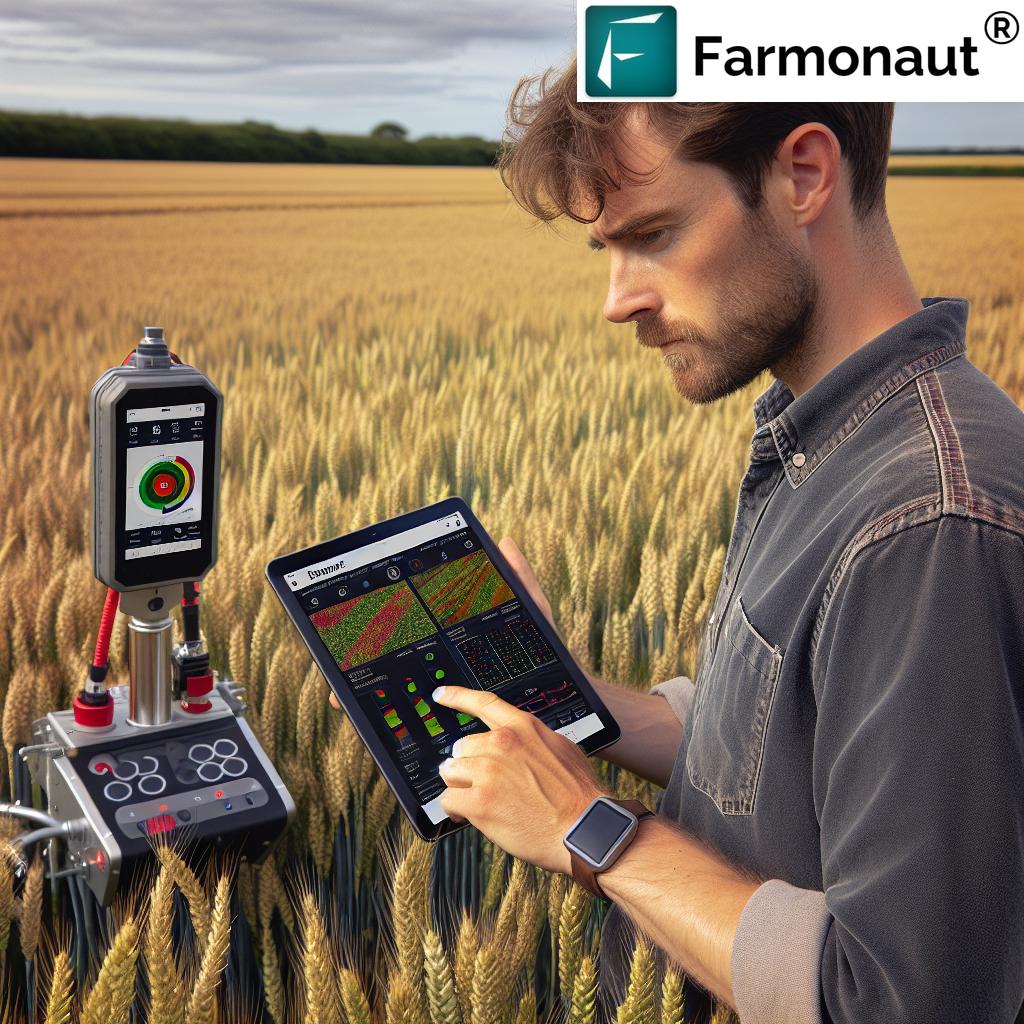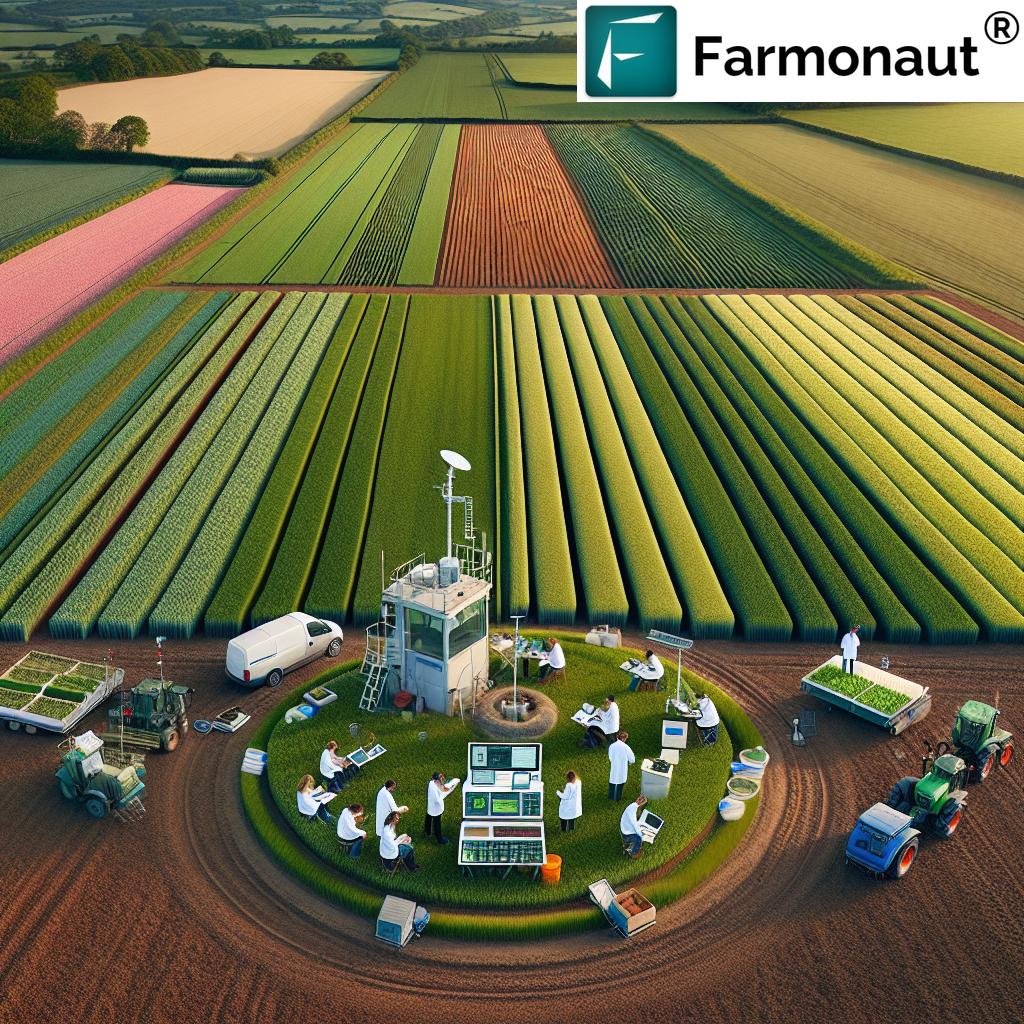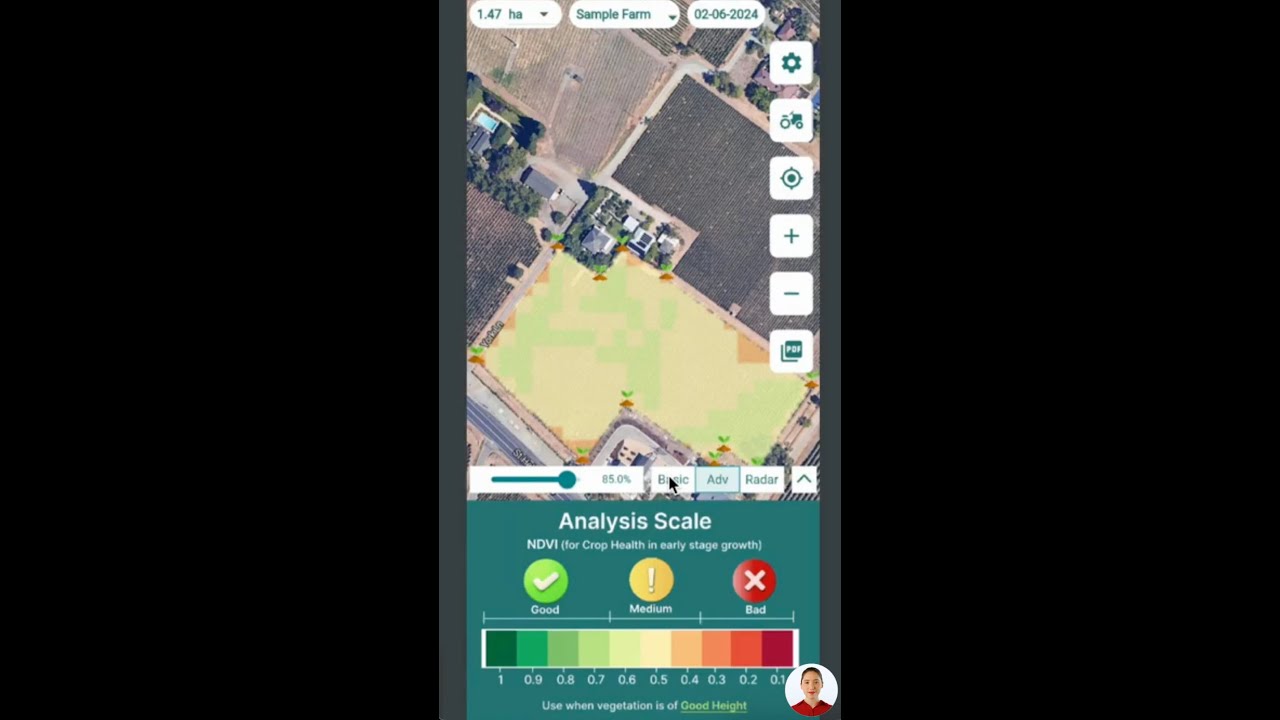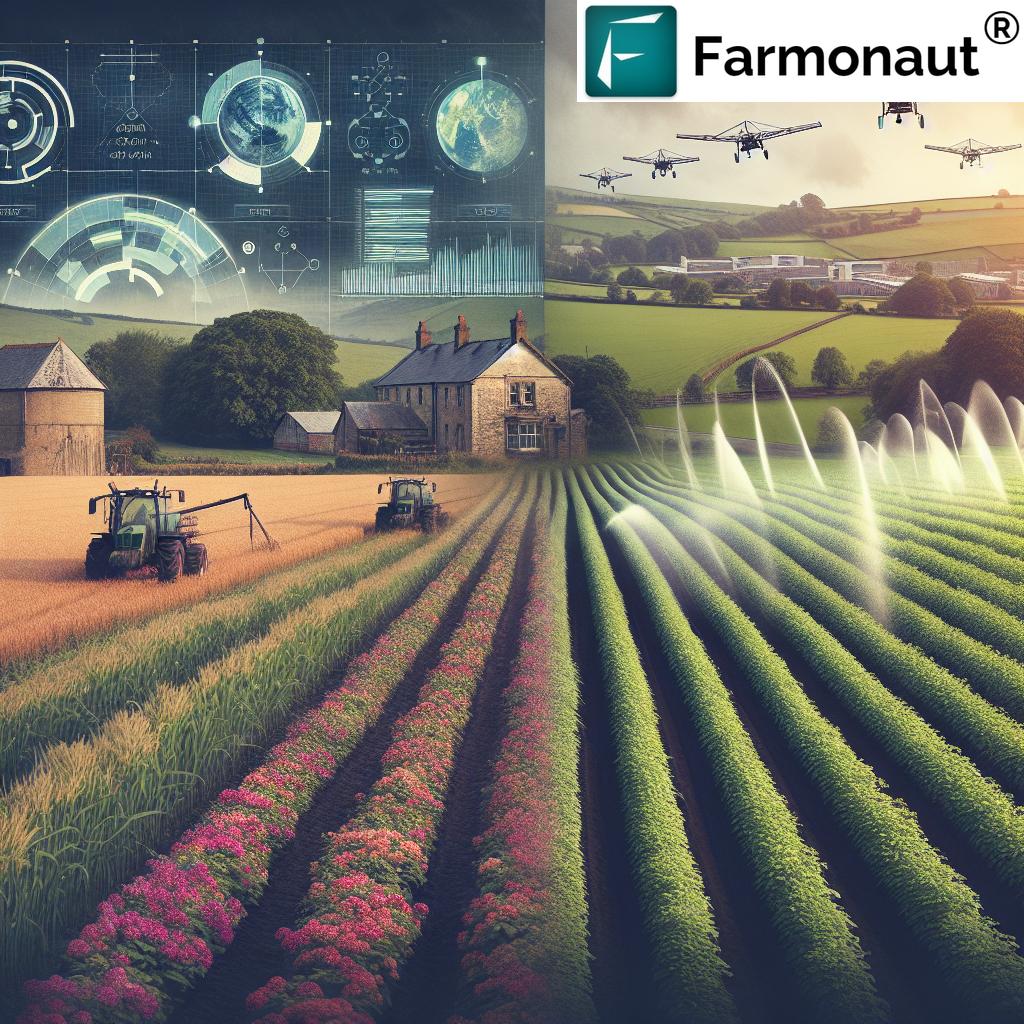Revolutionizing UK Cereal Crop Management: Farmonaut’s Advanced Wheat Bulb Fly Survey for Optimized Yield and Risk Mitigation
“Wheat bulb fly surveys in eastern England assess risk across 250,000 hectares of vulnerable cereal crops annually.”
In the ever-evolving landscape of UK agriculture, the management of cereal crops, particularly wheat, stands at the forefront of innovation and sustainability. As we navigate the complexities of modern farming, the need for precision agriculture technologies and advanced pest control strategies has never been more critical. At Farmonaut, we’re committed to revolutionizing cereal crop management through our cutting-edge agtech solutions, with a special focus on mitigating the risks posed by the wheat bulb fly – a persistent threat to wheat yields across the United Kingdom.

In this comprehensive exploration, we’ll delve into the intricate world of wheat bulb fly surveys, soil sampling techniques, and the latest advancements in agricultural pest control. Our journey will take us through the fertile fields of eastern England, where the threat of wheat bulb fly infestations looms largest, and showcase how Farmonaut’s innovative approach to farm data analytics and crop yield optimization is shaping the future of UK agriculture.
Understanding the Wheat Bulb Fly Challenge
The wheat bulb fly (Delia coarctata) has long been a thorn in the side of UK cereal growers, particularly in eastern England where conditions often favor its proliferation. This pest poses a significant threat to wheat crops, potentially causing substantial yield losses if left unchecked. Understanding the lifecycle and behavior of the wheat bulb fly is crucial for developing effective management strategies.
- Lifecycle: Adult flies emerge in July and August, laying eggs in bare soil or cereal stubbles.
- Risk Factors: Crops following potatoes, sugar beet, or fallow land are at higher risk.
- Damage: Larvae feed on the central shoots of wheat plants, leading to tiller death and reduced yields.
Given these challenges, the importance of accurate surveying and risk assessment cannot be overstated. This is where Farmonaut’s advanced technologies come into play, offering unprecedented insights into pest populations and crop vulnerabilities.
Farmonaut’s Innovative Approach to Wheat Bulb Fly Surveys
At Farmonaut, we’ve developed a state-of-the-art wheat bulb fly survey system that leverages satellite imagery, AI, and machine learning to provide farmers with real-time, actionable data. Our approach combines traditional soil sampling methods with cutting-edge technology to offer a comprehensive view of pest risk across vast agricultural landscapes.
Key components of our survey system include:
- Satellite-Based Crop Health Monitoring: We utilize multispectral satellite imagery to assess crop health and identify potential areas of infestation.
- AI-Driven Risk Assessment: Our Jeevn AI advisory system analyzes historical data, current crop conditions, and environmental factors to predict wheat bulb fly risk levels.
- Precision Soil Sampling: Guided by satellite data, we optimize soil sampling locations for maximum accuracy in egg count assessments.
By combining these technologies, we’re able to provide UK farmers with unparalleled insights into wheat bulb fly populations and their potential impact on crop yields.
Soil Sampling Techniques for Wheat Bulb Fly Assessment
Effective soil sampling is the cornerstone of accurate wheat bulb fly risk assessment. Our approach at Farmonaut integrates traditional sampling methods with advanced geospatial technologies to ensure comprehensive coverage and precise results.
Explore Farmonaut’s Web App for Advanced Crop Monitoring

Here’s an overview of our soil sampling process:
- Site Selection: Utilizing satellite imagery, we identify high-risk areas within fields for targeted sampling.
- Sampling Pattern: We employ a W-shaped sampling pattern across fields to ensure representative coverage.
- Sample Depth: Samples are taken to a depth of 10cm, where wheat bulb fly eggs are typically found.
- Sample Size: Each sample consists of 20 soil cores, providing a comprehensive view of egg populations.
- Timing: Sampling is conducted in autumn, aligning with the wheat bulb fly’s egg-laying period.
This meticulous approach to soil sampling, combined with our advanced data analytics, allows us to provide farmers with highly accurate risk assessments and tailored management recommendations.
The Impact of Crop Rotations on Wheat Bulb Fly Risk
Understanding the relationship between crop rotations and wheat bulb fly infestations is crucial for effective risk management. Our research at Farmonaut has revealed significant correlations between certain cropping patterns and increased pest pressure.
| Soil Type | Wheat after Potatoes | Wheat after Sugar Beet | Continuous Wheat | Wheat after Fallow |
|---|---|---|---|---|
| Clay | Medium | Medium | Low | High |
| Loam | High | High | Medium | High |
| Sandy | Medium | Medium | Low | Medium |
| Silty | High | High | Medium | High |
Legend:
Green (Low Risk): Minimal risk of wheat bulb fly infestation. Standard crop management practices are usually sufficient.
Yellow (Medium Risk): Moderate risk. Consider targeted monitoring and preventive measures.
Red (High Risk): Significant risk of infestation. Intensive monitoring and preventive treatments strongly recommended.
Key findings from our research include:
- Wheat crops following potatoes or sugar beet are at higher risk due to the bare soil conditions favored by egg-laying female flies.
- Continuous wheat cultivation tends to reduce risk, as it provides less favorable conditions for egg-laying.
- Fallow land can significantly increase risk, especially in clay and loam soils.
By incorporating this knowledge into our risk assessment models, we’re able to provide farmers with tailored recommendations for crop rotations that minimize wheat bulb fly risk while maintaining overall farm productivity.
Leveraging Farm Data Analytics for Pest Management
At Farmonaut, we believe that data is the key to unlocking superior pest management strategies. Our farm data analytics platform integrates multiple data sources to provide a holistic view of pest pressure and crop health.
Key components of our analytics platform include:
- Historical Data Analysis: We analyze past crop performance and pest incidence to identify trends and patterns.
- Real-Time Monitoring: Our satellite-based crop health monitoring provides up-to-date information on crop stress and potential pest hotspots.
- Predictive Modeling: By combining historical data with current conditions, we can forecast pest risk and potential yield impacts.
- Decision Support Tools: Our platform offers customized recommendations for pest management actions based on risk levels and crop stage.
This data-driven approach empowers farmers to make informed decisions about pest control measures, optimizing resource use and maximizing crop yields.
Explore Farmonaut’s API for Custom Integrations
“Proper soil sampling for wheat bulb fly can increase crop yields by up to 15% through targeted pest management.”
Sustainable Farming Practices for Wheat Bulb Fly Control
At Farmonaut, we’re committed to promoting sustainable farming practices that balance effective pest control with environmental stewardship. Our approach to wheat bulb fly management incorporates a range of eco-friendly strategies that reduce reliance on chemical interventions.

Key sustainable practices we recommend include:
- Crop Rotation Planning: Utilizing our data analytics to design rotations that naturally suppress wheat bulb fly populations.
- Cover Cropping: Implementing cover crops to reduce bare soil exposure and limit egg-laying opportunities.
- Biological Control: Encouraging natural predators of wheat bulb fly through habitat management.
- Precision Application: Using our satellite data to target pest control measures only where needed, reducing overall pesticide use.
- Resistant Varieties: Recommending wheat varieties with enhanced resistance to wheat bulb fly damage.
By adopting these practices, farmers can significantly reduce their environmental impact while maintaining high crop yields and quality.
The Role of Precision Agriculture in Wheat Bulb Fly Management
Precision agriculture technologies are at the heart of Farmonaut’s approach to wheat bulb fly management. By leveraging advanced tools and techniques, we’re able to provide farmers with unprecedented control over their pest management strategies.
Key precision agriculture technologies we employ include:
- Variable Rate Application: Our satellite data guides the precise application of seed treatments and pesticides, ensuring optimal coverage while minimizing waste.
- GPS-Guided Soil Sampling: We use GPS technology to ensure accurate and repeatable soil sampling for consistent monitoring of wheat bulb fly populations.
- Drone Surveys: In addition to satellite imagery, we utilize drone technology for high-resolution crop scouting and pest detection.
- IoT Sensors: Our network of Internet of Things (IoT) sensors provides real-time data on soil conditions and crop health, enhancing our predictive capabilities.
These precision agriculture tools, combined with our advanced analytics, enable farmers to implement highly targeted and effective wheat bulb fly management strategies.
Access Farmonaut’s API Developer Docs for Custom Solutions
The Economic Impact of Effective Wheat Bulb Fly Management
Understanding the economic implications of wheat bulb fly infestations and their management is crucial for UK cereal growers. At Farmonaut, we’ve conducted extensive research to quantify the financial benefits of effective pest control strategies.
Key economic factors to consider include:
- Yield Impact: Severe wheat bulb fly infestations can reduce yields by up to 30%, significantly affecting farm income.
- Treatment Costs: While pest control measures incur costs, our precision approach ensures optimal resource allocation for maximum ROI.
- Quality Premiums: Effective management not only preserves yield but also maintains grain quality, potentially securing premium prices in the market.
- Long-term Sustainability: Our integrated approach promotes soil health and biodiversity, contributing to long-term farm profitability.
By leveraging Farmonaut’s advanced technologies and insights, farmers can make informed decisions that balance short-term pest control needs with long-term economic sustainability.
Future Trends in Cereal Crop Management and Pest Control
As we look to the future of UK agriculture, several emerging trends are set to reshape cereal crop management and pest control strategies. At Farmonaut, we’re at the forefront of these innovations, continuously evolving our platform to meet the changing needs of farmers.
Key trends we’re monitoring and integrating into our solutions include:
- AI-Driven Predictive Modeling: Advanced machine learning algorithms will enable even more accurate forecasting of pest outbreaks and crop vulnerabilities.
- Blockchain for Traceability: Our blockchain-based solutions will provide enhanced transparency in the food supply chain, from farm to consumer.
- Climate-Resilient Crop Varieties: We’re collaborating with plant breeders to develop wheat varieties with improved resistance to wheat bulb fly and other pests.
- Integrated Pest Management (IPM) 2.0: The next generation of IPM will leverage big data and AI to create holistic, ecosystem-based pest management strategies.
- Autonomous Farm Equipment: Self-driving tractors and drones will enable ultra-precise application of pest control measures based on our real-time data insights.
By staying ahead of these trends, Farmonaut ensures that UK cereal growers have access to the most advanced and effective crop management tools available.
Download Farmonaut’s Android App for On-the-Go Crop Monitoring

Conclusion: Empowering UK Farmers for a Sustainable Future
As we’ve explored throughout this comprehensive guide, effective management of wheat bulb fly and other cereal crop pests is crucial for the success and sustainability of UK agriculture. At Farmonaut, we’re committed to empowering farmers with the tools, data, and insights they need to navigate these challenges and optimize their crop yields.
Our advanced wheat bulb fly survey techniques, combined with cutting-edge farm data analytics and precision agriculture technologies, offer a powerful solution for mitigating pest risks and maximizing farm productivity. By embracing these innovative approaches, UK cereal growers can not only protect their crops from the threat of wheat bulb fly but also position themselves at the forefront of sustainable, high-yield farming practices.
As we look to the future, Farmonaut will continue to innovate and evolve our platform, ensuring that UK farmers have access to the most advanced agtech solutions available. Together, we can build a more resilient, productive, and sustainable agricultural sector that meets the growing demands of our global food system while preserving the health of our planet.
Get Farmonaut’s iOS App for Seamless Farm Management

FAQs
- What is the wheat bulb fly, and why is it a concern for UK cereal growers?
The wheat bulb fly (Delia coarctata) is a pest that can cause significant damage to wheat crops, particularly in eastern England. It lays eggs in bare soil, and the larvae feed on the central shoots of wheat plants, potentially leading to substantial yield losses if not properly managed. - How does Farmonaut’s technology help in wheat bulb fly risk assessment?
Farmonaut uses satellite imagery, AI, and machine learning to provide real-time crop health monitoring and pest risk assessment. Our system combines this data with traditional soil sampling techniques to offer comprehensive insights into wheat bulb fly populations and potential crop impacts. - What are the best practices for soil sampling in wheat bulb fly surveys?
Effective soil sampling involves selecting representative sites, using a W-shaped sampling pattern, taking samples to a depth of 10cm, and collecting 20 soil cores per sample. Sampling should be conducted in autumn to align with the wheat bulb fly’s egg-laying period. - How do crop rotations affect wheat bulb fly risk?
Certain crop rotations can significantly influence wheat bulb fly risk. Wheat crops following potatoes, sugar beet, or fallow land are generally at higher risk due to favorable egg-laying conditions. Continuous wheat cultivation tends to reduce risk by providing less suitable conditions for the pest. - What sustainable farming practices can help control wheat bulb fly populations?
Sustainable practices include strategic crop rotation planning, cover cropping to reduce bare soil exposure, encouraging natural predators through habitat management, precision application of pest control measures, and using resistant wheat varieties.

















